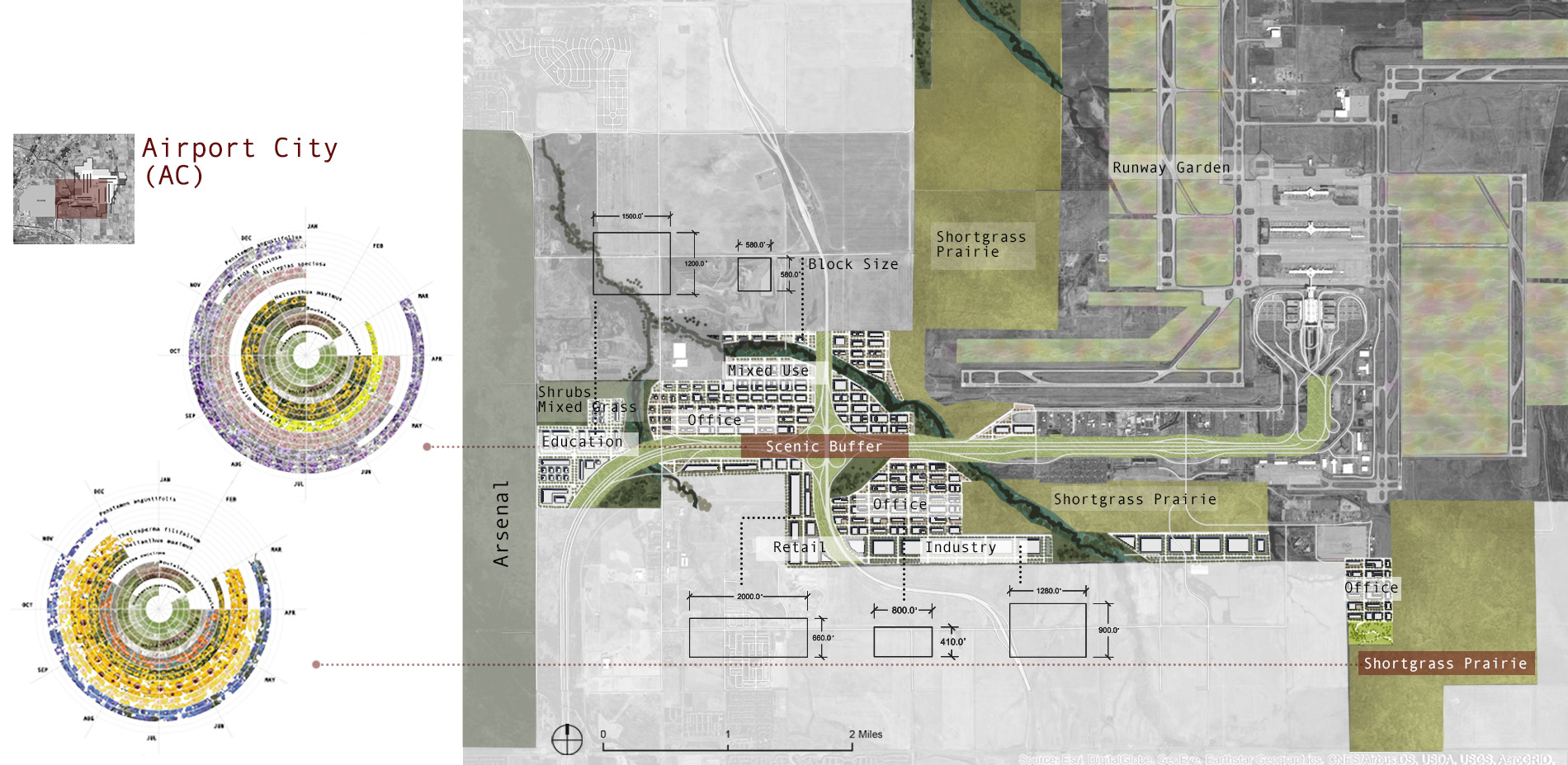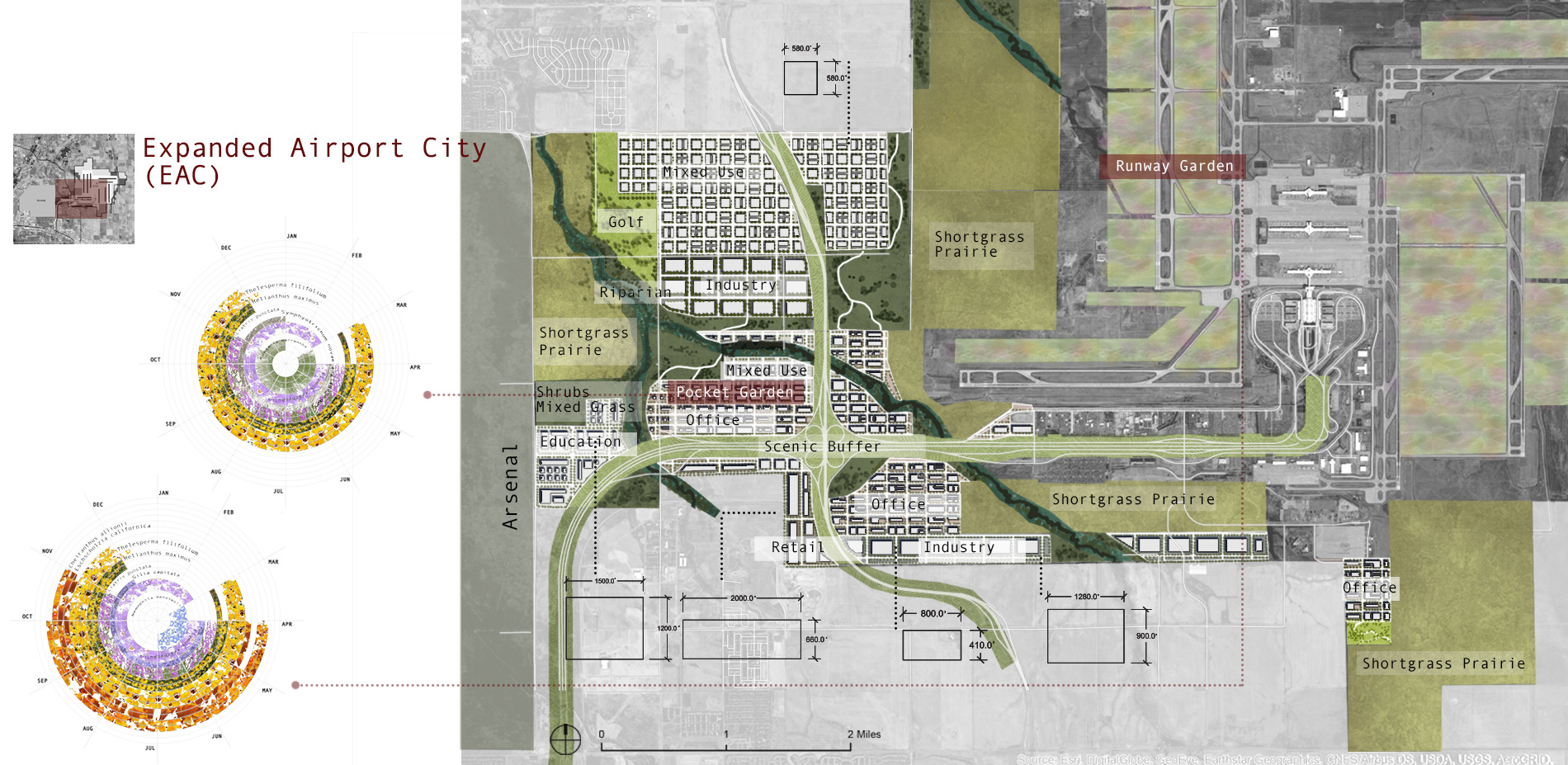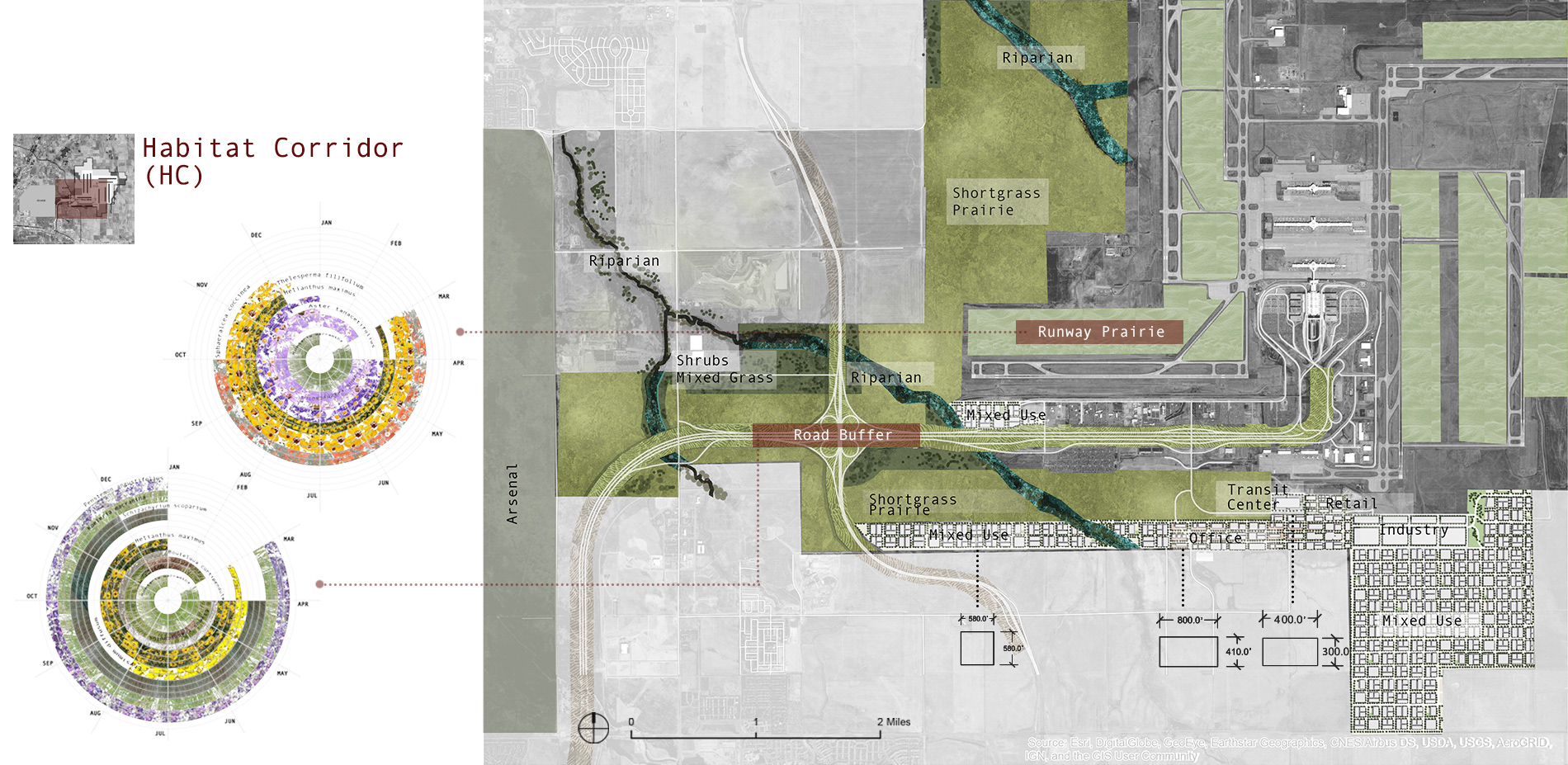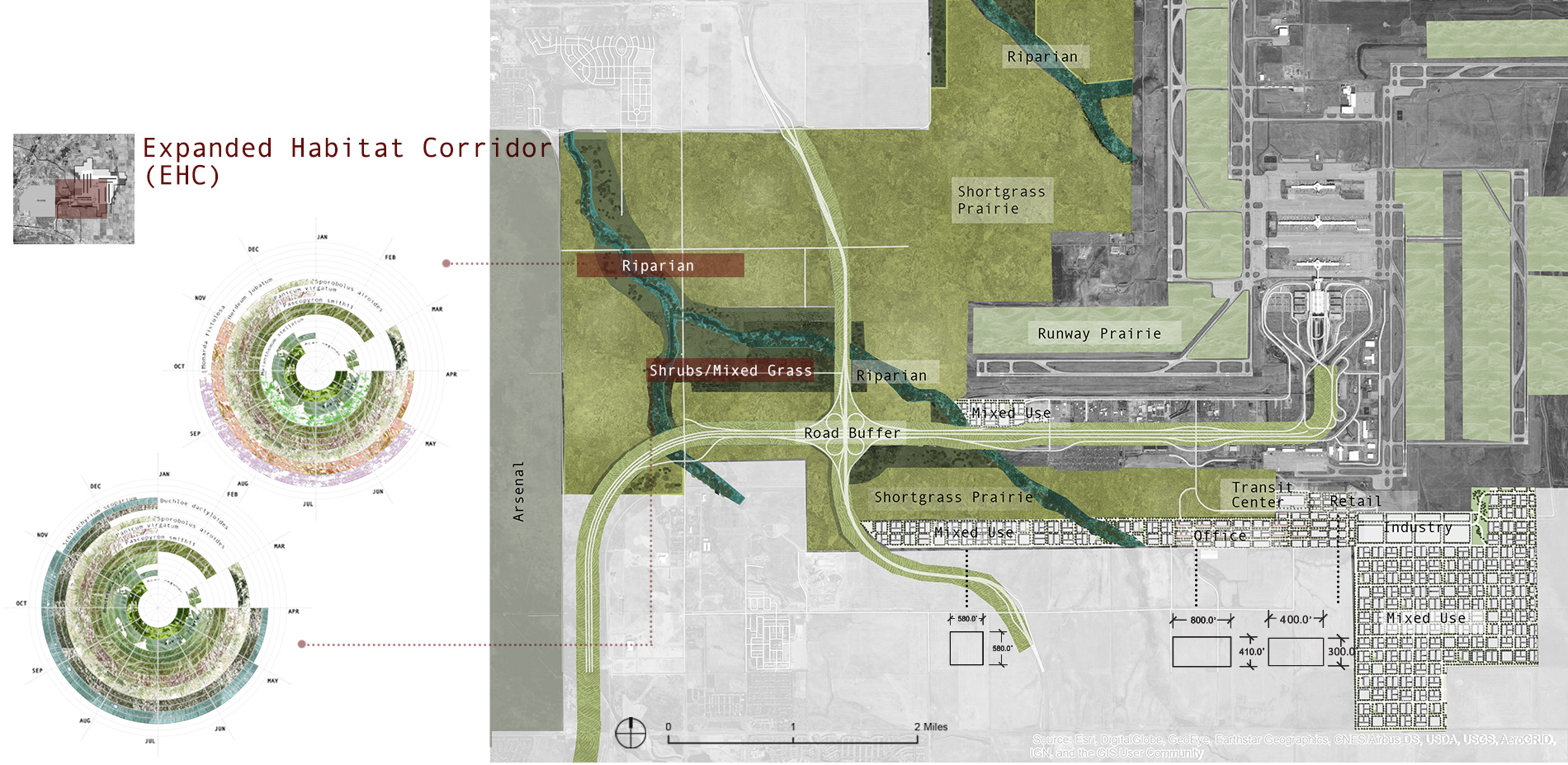This research examined the potential to incorporate pollinator habitats in human-dominated landscapes through normative scenarios, using Denver International Airport as a case study. Four scenarios were envisioned under the prioritized drivers of developing an airport city or pollinator habitats within two possible property boundaries. Landscape patterns were created accordingly, then modeled and compared against each other in terms of relative pollinator abundance at the landscape level. The study results suggested that human dominance could exert negative impacts on pollinator abundance at the landscape scale, which was hard to compensate for through small urban pollinator gardens. But strategically establishing large-sized, high-quality habitats and more integrated land management strategies such as land claiming or innovative collaborations across adjacent properties emerged as promising opportunities.
Denver International Airport (DEN) as an example to incorporate pollinator habitats in human-dominated areas
It is challenging but important to create and enhance pollinator habitats in urban areas with rapid population growth and high development demands. Denver International Airport (DEN), the largest airport property in the U.S, is an example of such a sites
Opportunities and challenges offered by the unique location of DEN
DEN’s proximity to both the fast-growing Metro Denver area and the Rocky Mountain Arsenal Wildlife Refuge’s restored shortgrass prairie ecosystem offers great opportunities for developing an airport city as well as creating pollinator habitats on the relatively open land.
Pollinator Species
Four guilds of bees and three guilds of butterflies were identified as the study interest. Information about nesting needs, flight distance, seasonal activity levels, and relative abundance in the region was collected for modeling and evaluation.
The approach of normative scenarios
Built on a framework developed by other scholars, we looked into existing data, hypothesized four sets of landscape patterns under two priorities and two boundaries through an iterative process, and tested the scenarios in terms of relative pollinator abundance.
Nine habitat typologies for desired pollinator support
Nine habitat typologies were proposed to achieve desired outcomes to support pollinators in different locational contexts, with plant species selected according to the nesting and forage needs of target bee guilds. The applied typologies and their layout varied across scenarios.
Assumptions across four scenarios
Existing planning documents were used as reference to formulate hypotheses for scenarios, and two distinct drivers (establishing an airport city v.s. providing pollinator habitats; boundary remaining as now v.s. expanded for flexibility) were used to determine landscape patterns.
Metrics for modeling and evaluation
The modeling for relative pollinator abundance was based on two factors: the characteristics of bee guild, which determined the demands on habitats, and the biophysical features of the landscape patterns, which represented the capacity to provide habitats.
4 Scenarios
Scenario Airport City (AC) and associated outcomes
Development was prioritized within the existing boundary. The airport served as a welcoming gesture that could accommodate a variety of functions along the core boulevard. Pocket gardens acted as small feeding sites throughout developed areas.
Scenario Expanded Airport City (EAC) and associated outcomes
Development was prioritized with an expanded boundary and introduced onto the additional land, while the area within the current property line stayed the same as AC. Besides pocket gardens, continuous shortgrass prairie habitat between Arsenal and DEN was also established.
Scenario Habitat Corridor (HC) and associated outcomes
Habitat was prioritized within the existing boundary. The core corridor was used to connect to Arsenal to establish higher-quality wildlife habitat and consolidated development was kept in the south, offering authentic natural experiences of the region to people.
Scenario Expanded Habitat Corridor (EHC) and associated outcomes
Habitat was prioritized with an expanded boundary and introduced onto the additional land, while the development pattern remained the same as HC. The agricultural land on the north will also be persevered and could become a new non-airline revenue source.




The spatial distribution of relative pollinator abundance across seasons
Based on input data, InVEST model generated an abundance index ranging from 0 to 1 for each guild of bees, in each season, in each of the four scenarios as a prediction of the landscape patterns’ capacity to support pollinators.
Results
The negative impact of human dominance on pollinator abundance, although hard to be compensated for by urban gardens, may be effectively reduced through strategically locating development zones, introducing high-quality habitats, or innovative land development and management collaborations.
Discussion
According to our study, human dominance could negatively impact pollinator abundance. Although previous studies indicated that small urban patches like gardens and parks with dense floral resources can provide habitat for pollinators [12, 17], in our case, including pollinator gardens in developed areas was not enough to compensate for the loss of habitat associated with development in the larger scopes. However, there may be other opportunities. First, strategically locating development zones and using the land of less development significance for large-sized, high-quality habitat may predict high pollinator abundance overall that can even outperform a scenario prioritizing habitat. Secondly, claiming adjacent land or establishing collaborative land development and management strategies across adjacent properties presents new opportunities for supporting pollinators, since even when the expansion occurred in a developed area, the average pollinator abundance across the landscape can increase.
Using DEN as a specific example, we aimed to gain a better understanding of the potential for incorporating pollinator habitats in human-dominated landscapes. By creating and modeling normative scenarios that are plausible but not necessarily considered in traditional landscape planning practice, we demonstrated the significance of applying normative scenarios in the early stage of landscape planning in a manner where empirical creativity and knowledge can be robustly examined to provide useful insights and open up new opportunities.